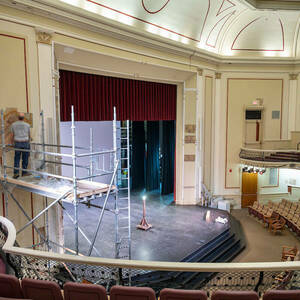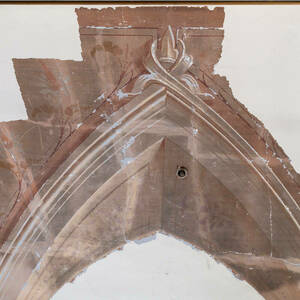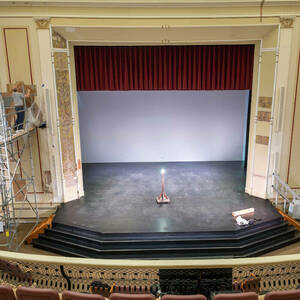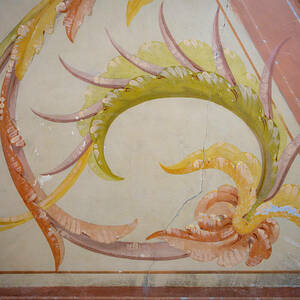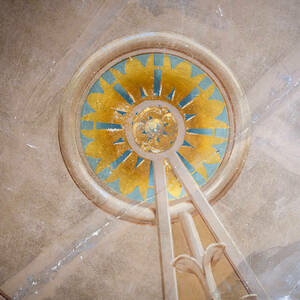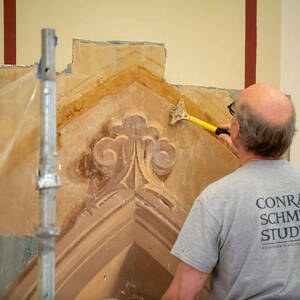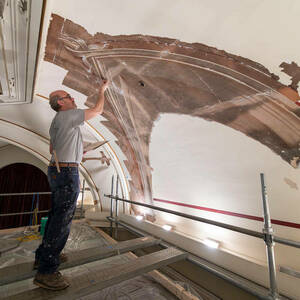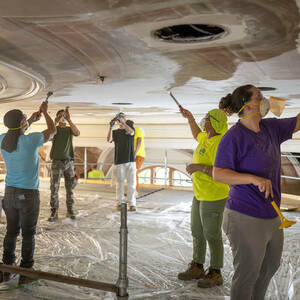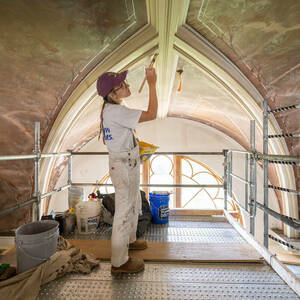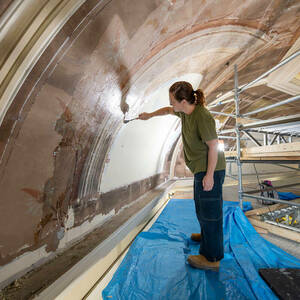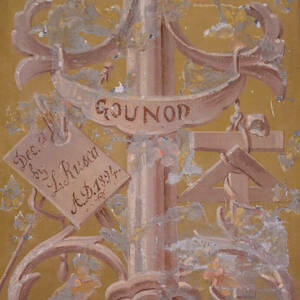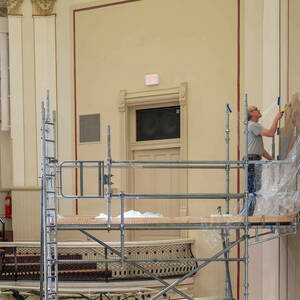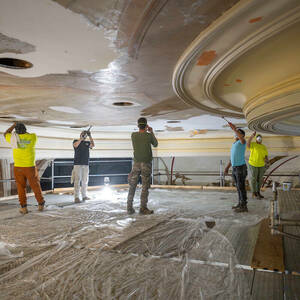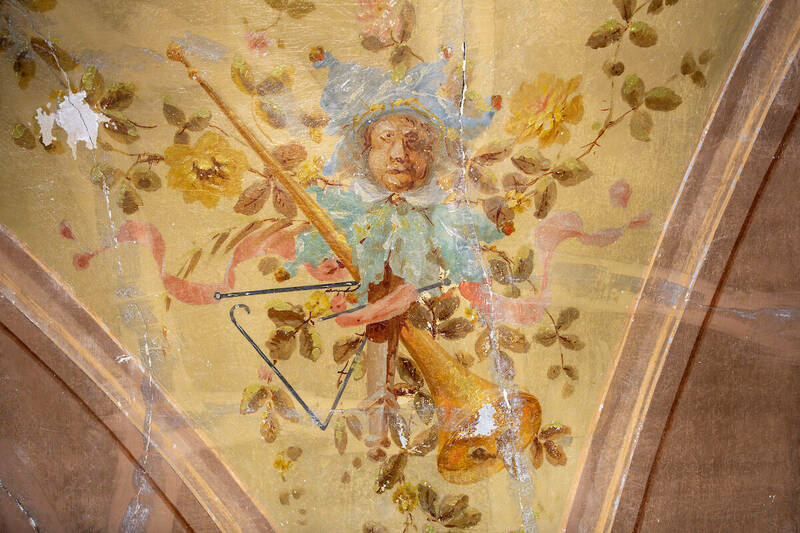 An 1894 painting uncovered in Washington Hall. Photography by Barbara Johnston
An 1894 painting uncovered in Washington Hall. Photography by Barbara Johnston
Editor’s Note: This is the first in a Notre Dame Magazine series chronicling the interior renovation of Washington Hall, the University’s 143-year-old campus auditorium.
Inch by inch, Jill Eide hand scrapes layers of paint off the ceiling in Washington Hall. As the discarded bits fall to the scaffolding at her feet, 19th-century colors and artistry are revealed.
A delicate filigree motif comes to light. Nearby, vibrant shades of gold, plum and olive green form an intricate swirl near a corner of the ceiling. Vines, flowers, leaves and scrollwork appear.
Eide continues her task, carefully wielding a tiny scraper just a half-inch wide. “When we started, we were dazzled by how much is still here,” says Eide, an art conservator with Conrad Schmitt Studios.
In May, workers removed the seats and floor in Washington Hall, Notre Dame’s 143-year-old campus auditorium. Scaffolding was installed inside, allowing workers to easily reach all the walls and the ceiling.
This summer, a major renovation of the auditorium is underway. The work is scheduled to finish in October.
The project will recreate much of the high Victorian interior artistic details that were added inside Washington Hall in 1894 by Luigi Gregori and Louis Rusca, the artists who also decorated the interior of the Main Building and Sacred Heart Basilica. (The artwork in both those buildings has been painstakingly restored in recent decades.)
The Gregori/Rusca auditorium decor gradually faded over time. What remained was covered with gray paint in 1956 during a remodeling and modernization project.
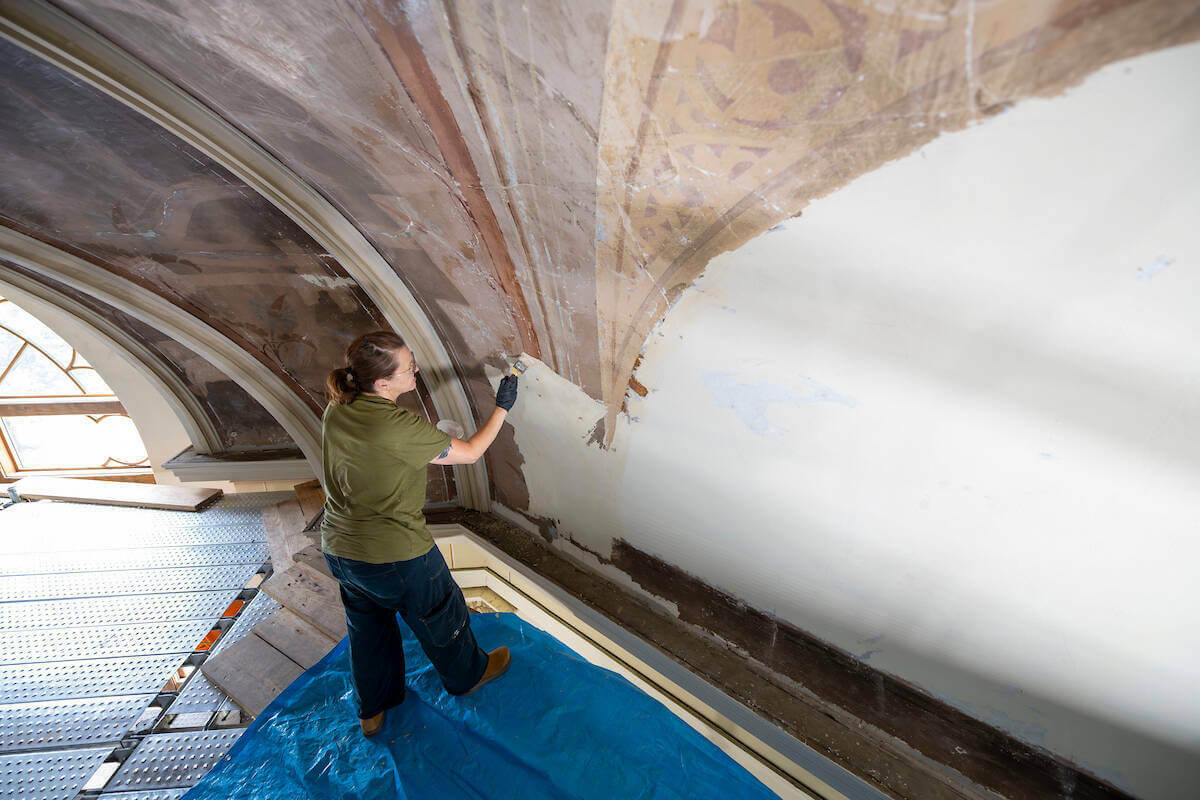
The history of the building and details of the 1890s decor is described in Washington Hall at Notre Dame, a 2011 book by Mark Pilkinton, now a professor emeritus of film, television and theater. In the book, the author made a case for reviving the Gregori/Rusca creations.
Now it’s happening.
Tony Polotto, the University’s senior director of construction and quality assurance, says peeling paint, worn seats and needed safety upgrades prompted the work on Washington Hall. Initial exploratory work occurred in February, when small sections of paint were stripped in a few areas, revealing some of the 1890s details.
This summer, the auditorium is a busy hive of activity. In addition to workers carefully removing layers of paint on the walls and ceiling, discovering what lies beneath, others apply fresh coats matched to the 19th-century shades along stretches of wood and plaster.
The artistic work is being led by craftsmen from Conrad Schmitt Studios, the Wisconsin-based firm the University has relied on for decades to restore the interior of the Main Building and the basilica, maintain the “Word of Life” mosaic on the Hesburgh Library and regild the Golden Dome.
The 1890s auditorium included gold accents, created with a mica or a similar artificial gold substance. Those details will be recreated during this project with real gold leaf.
“It will shine like crazy,” says Bryon Roesselet, senior artist for Conrad Schmitt. “The gold leaf really pops.”
Roesselet and Eide, lead artists on the Washington Hall project, also led the team that regilded the Golden Dome in 2023.
Inside Washington Hall, the ornate decor above the proscenium was plastered over at some point, so the details were destroyed. However, a few photographs of the original exist. And the workers uncovered identical scrollwork on the theater’s back wall, which will be used to recreate the pattern above the proscenium.
“The main intent of this project is to renovate the space,” with new seating, new LED lighting and safety upgrades, Polotto says. “In the process, we have the benefit of exposing some of the beautiful artwork that was in that building. It isn’t meant to be a historic restoration or a duplication of exactly what was there.”
There will be new carpet with a large floral pattern in the aisles and new faux wood flooring beneath the seats to provide for the best acoustics. The new seats will be a shade of persimmon with cast iron end panels. The renovated auditorium will seat 546 people, the same capacity as before.
Washington Hall was built in 1881 and dedicated the following year. It replaced a music hall that burned during the Great Fire of 1879. It was designed by Willoughby J. Edbrooke, the Chicago architect who also had designed the new Main Building after the fire.
Notre Dame founder Rev. Edward Sorin, CSC, a French immigrant, named the building in honor of one of his heroes, the first U.S. president George Washington. Washington Hall served as the University’s primary auditorium until the DeBartolo Performing Arts Center opened in 2004. The hall remains in frequent use for lectures, student theater productions and other events.
The 1890s interior decor included portraits of Washington (over the stage) and several prominent European writers and artists, as well as emblematic figures representing tragedy, comedy, music and poetry.
Those portraits on canvas, by Gregori, were removed during the 1956 remodeling and are believed lost, Pilkinton reported in his book.
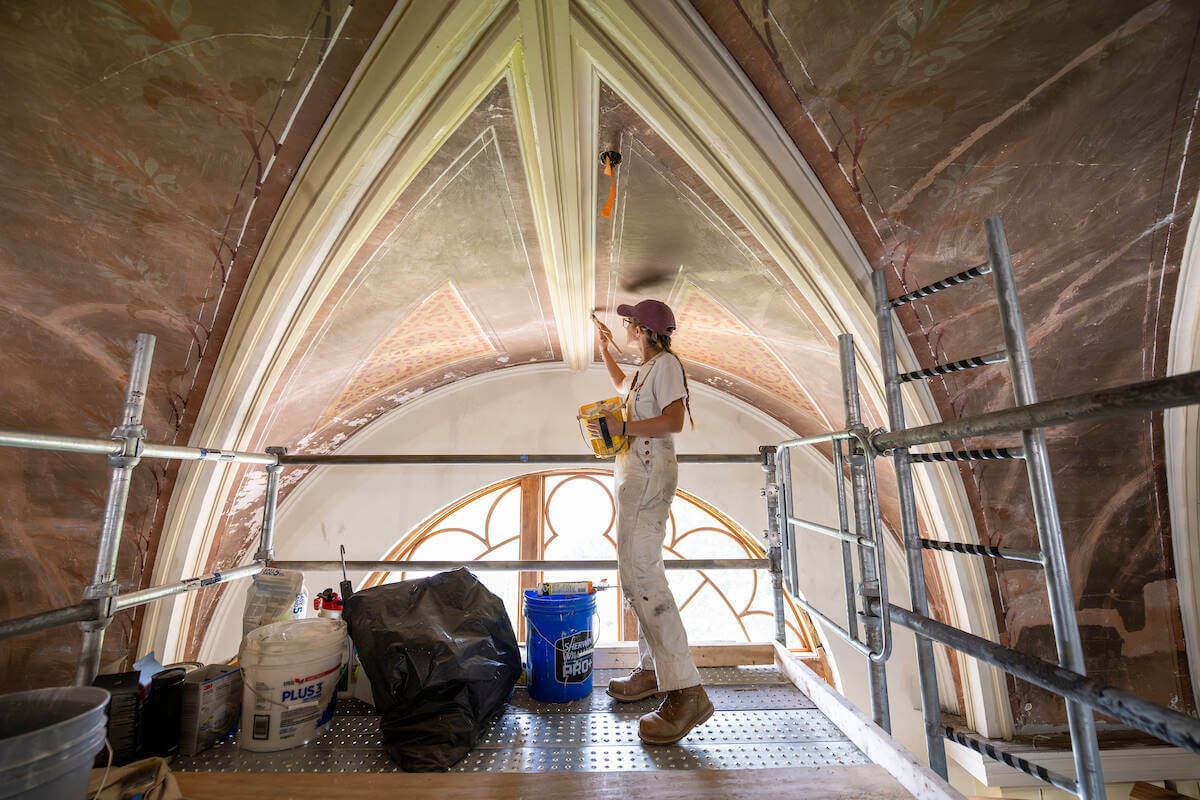
An 1894 Scholastic article described the auditorium’s artwork: “The ceiling is especially beautiful in design and color. It is divided into six large panels of a light olive tint, decorated with delicately limned ornaments springing forth in curved lines from four round golden frames containing portraits of Shakspere (sic), Molière, Mozart and Beethoven, painted by Gregori. From the centre of the ceiling rises a gracefully curved dome adorned with festoons of flowers and trailing vines on a background of the brightest tints seen in a morning sky. A large curved space, twelve feet wide, connecting the walls with the ceiling is embellished with skillfully executed niches, containing sitting figures of Tragedy, Comedy, Music and Poetry. These allegorical representations are of majestic proportions, graceful in pose and brilliant in color. They stand out in bold relief from landscapes softened with heavenly hues.”
Gregori, a Notre Dame art professor from 1874 to 1891, had retired to Italy. He completed the portraits abroad and shipped them to the University with instructions on how to affix them to the auditorium’s walls and ceiling. The rest of the decor is known to be the work of Rusca, a Swiss-Italian immigrant and Chicago-based fresco artist who specialized in trompe l'oeil — a surface painting or design that creates the illusion of a three-dimensional object — and his assistant, a Mr. Poligano.
The 1890s decor included figures of Demosthenes, a Greek statesman and orator, and Cicero, a Roman statesman and philosopher, in trompe l'oeil niches between marbleized columns on either side of the stage.
Shortly after the interior was complete, the Chicago Daily Tribune described Washington Hall as “the most beautifully finished, of any college theater, in the country.”
Over its long history, the auditorium has been the scene of commencements, film screenings, St. Patrick’s Day celebrations, debates, speeches. and countless theatrical and musical performances. (During his undergraduate years, Knute Rockne — long before he became a famed Notre Dame football coach — performed in student theatricals in Washington Hall.)
Of all the artistic performances that have occurred inside Washington Hall, the renovation of the grand interior will be among its most engaging.
Margaret Fosmoe is an associate editor of this magazine. Contact her at mfosmoe@nd.edu or @mfosmoe.

